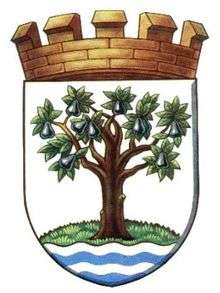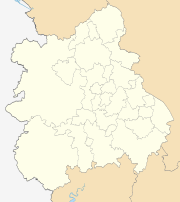Worcestershire
Worcestershire (/ˈwʊstərʃər/ (![]()
| Worcestershire | |||||
|---|---|---|---|---|---|
| Ceremonial county | |||||
| |||||
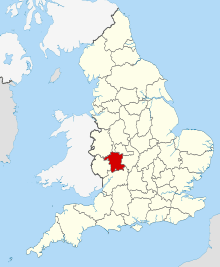 | |||||
| Sovereign state | United Kingdom | ||||
| Constituent country | England | ||||
| Region | West Midlands | ||||
| Established | 1 April 1998 | ||||
| Established by | Local Government Commission for England | ||||
| Preceded by | Hereford and Worcester | ||||
| Origin | Ancient | ||||
| Ceremonial county | |||||
| High Sheriff | Edward Holloway[1] (2019–2020) | ||||
| Area | 1,741 km2 (672 sq mi) | ||||
| • Ranked | 34th of 48 | ||||
| Population (mid-2019 est.) | 592,057 | ||||
| • Ranked | 38th of 48 | ||||
| Density | 340/km2 (880/sq mi) | ||||
| Ethnicity | 92.4% White British 3.4% White Other 2.4% Asian 0.4% Black 1.4% Other/Mixed[2] | ||||
| Non-metropolitan county | |||||
| County council | Worcestershire County Council[3] | ||||
| Executive | Conservative | ||||
| Admin HQ | Worcester | ||||
| Area | 1,741 km2 (672 sq mi) | ||||
| • Ranked | 22th of 26 | ||||
| Population | 595786 | ||||
| • Ranked | 21th of 26 | ||||
| Density | 342/km2 (890/sq mi) | ||||
| ISO 3166-2 | GB-WOR | ||||
| ONS code | 47 | ||||
| NUTS | UKG12 | ||||
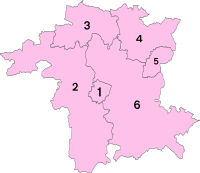 Districts of Worcestershire | |||||
| Districts | |||||
| Members of Parliament | |||||
| Time zone | Greenwich Mean Time (UTC) | ||||
| • Summer (DST) | British Summer Time (UTC+1) | ||||
The cathedral city of Worcester is the largest settlement and county town. The major towns include Bromsgrove, Droitwich, Evesham, Kidderminster, Malvern, Redditch, and Stourport-on-Severn. The historic county also contained Dudley, Stourbridge, Halesowen, Oldbury, Yardley, Kings Norton and Northfield, whilst the rest of Worcestershire is largely rural. The current administrative county is divided into six districts: Worcester, Redditch, Wychavon, Malvern Hills, Wyre Forest, and Bromsgrove.
The area that is now Worcestershire was absorbed into the unified Kingdom of England in 927, at which time it was constituted as a county (see History of Worcestershire). Over the centuries the county borders have been modified, but it was not until 1844 that substantial changes were made. This culminated with the abolition of Worcestershire in 1974 with its northern area becoming part of the West Midlands and the rest part of the county of Hereford and Worcester. However, in 1998 the county of Hereford and Worcester was abolished and Worcestershire was reconstituted without the northern area ceded to the West Midlands.
Location
The county borders Herefordshire to the west, Shropshire to the north-west, Staffordshire only just to the north, West Midlands to the north and north-east, Warwickshire to the east and Gloucestershire to the south. The western border with Herefordshire includes a stretch along the top of the Malvern Hills. At the southern border with Gloucestershire, Worcestershire meets the northern edge of the Cotswolds. Two major rivers flow through the county: the Severn and the Avon.
History
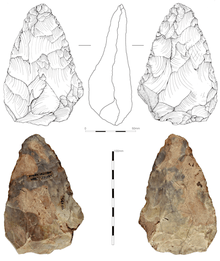
The geographical area now known as Worcestershire was first populated at least 700,000 years ago. The area became predominantly agricultural in the Bronze Age, leading to population growth and more evidence of settlement. By the Iron Age, hill forts dominated the landscape. Settlement of these swiftly ended with the Roman occupation of Britain.
The Roman period saw establishment of the villa system in the Cotswalds and Vale of Evesham. Droitwich (Salinae) was probably the most important settlement in the county in this period, due to its product of salt. There is also evidence for Roman settlement and industrial activity around Worcester and King's Norton.
Anglo-Saxon and Norman Worcestershire
The area which became Worcestershire formed the heartland of the Anglo-Saxon kingdom of the Hwicce. It was absorbed by the Kingdom of Mercia during the 7th century and became part of the unified Kingdom of England in 927. Worcestershire was established as an administrative and defensive unit in the early tenth century.[4] Its purpose was to take into account and defend the estates within the northern area of the historic See of Worcester, held by the Episcopus Hwicciorum and Worcester Priory, along with the Abbots of Pershore, Westminster and Evesham.[5] The shires and its sub-divisions known as hundreds, formed a framework for administering the resources of each burhs' outlying estates.[6] It was a separate ealdormanship briefly in the 10th century before forming part of the Earldom of Mercia in the 11th century. The last known Anglo-Saxon Sheriff of Worcestershire was Cyneweard of Laughern. After the Norman conquest of England; the Domesday Book noted in 1086 that in seven of the twelve hundreds covering Worcestershire, the Crown had no authority. The Crown's authority was replaced by the Bishop of Worcester and the Abbots at Pershore, Westminster and Evesham.[7] William the Conquerer gave to his allies and friends manors and parishes captured from the Anglo-Saxons. According to the Domesday Book; King William gave Dudley and other manors such as Selly Oak, Bartley Green, Northfield, Frankley, and Bromsgrove (Willingwick) to Ansculf de Picquigny - Sheriff of Buckinghamshire,[8] and Hala to Roger de Montgomerie, who became Earl of Shrewsbury.[9] Whilst Doddingtree Hundred was gifted to Raoul II of Tosny, seigneur de Conches-en-Ouche,[10] Ranulph de Mortimer, and Osbern Fitz Richard. Despite the Norman Conquest; the rest of the county was still held by the Abbeys of Pershore and Evesham, the Bishop of Worcester and Priory - these hundreds became known as Oswaldslow and Fisseberge (latterly Blakenhurst), along with the unnamed hundreds of Pershore and Westminster. The first Norman Sheriff Urse d'Abetot, built the castle of Worcester and seized much church land, some of which became part of the Crown's hundreds in Worcestershire - Dimidii Comitatus de Wych (which became known as Halfshire) and Doddingtree.[11][12] d'Abetot was in dispute with Bishop Wulfstan over the rights of the sheriff in the lands of Oswaldslow, and Blakenhurst.[13][14] Meanwhile, in Halfshire; landowners in Alvechurch, Hanbury, and Inkberrow handed over their manors to the church, effectively transferring jurisdiction to Oswaldslow.[12]
Medieval
During the Middle Ages, much of the county's economy was based on the wool trade. Many areas of its dense forests, such as Feckenham Forest, Horewell Forest and Malvern Chase, were royal hunting grounds subject to forest law.
On 4 August 1265, Simon de Montfort was killed in the Battle of Evesham in Worcestershire.
Civil War
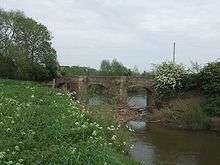
In 1642, the Battle of Powick Bridge was the first major skirmish of the English Civil War. The county suffered from being on the Royalist front line, as it was subject to heavy taxation and the pressing of men into the Royalist army, which also reduced its productive capacity. The northern part of the county, which was already a centre of iron production, was important for military supplies. Parliamentarian raids and Royalist requisitioning both placed a great strain on the county.
There were tensions from the participation of prominent Catholic recusants in the military and civilian organisation of the county. Combined with the opposition to requisitioning from both sides, bands of Clubmen formed to keep the war away from their localities.
The Battle of Worcester in 1651 effectively ended the third civil war. There was little enthusiasm or local participation in the mostly Scottish Royalist army, whose defeat was widely welcomed. Nevertheless, Parliamentarian forces ransacked the city of Worcester, causing heavy damage, looting and destruction of property. Around 10,000 mostly Scottish prisoners were sent into forced labour in the New World or fen drainage schemes. The small bands of Scots that fled into Worcestershire's countryside were attacked by local forces and killed.
Nineteenth century
In the 19th century, Worcester was a centre for the manufacture of gloves; the town of Kidderminster became a centre for carpet manufacture, and Redditch specialised in the manufacture of needles, springs and hooks. Droitwich Spa, situated on large deposits of salt, was a centre of salt production from Roman times, with one of the principal Roman roads running through the town. These old industries have since declined, to be replaced by other, more varied light industry. The county is also home to the world's oldest continually published newspaper, the Berrow's Journal, established in 1690. Malvern was one of the centres of the 19th-century rise in English spa towns due to Malvern water being believed to be very pure, containing "nothing at all".[15]
Demographics
The 2011 census found the population of Worcestershire to be 566,169, an increase of 4.4% from the 2001 population of 542,107.
Ethnicity
Though the total number of people in every ethnic group increased between 2001–11, the White British share of Worcestershire's population decreased from 95.5% to 92.4%, as did the share of White ethnic groups as whole, which went from 97.5% to 95.7%. Worcestershire is still much more ethnically homogeneous than the national average. In 2011, 79.8% of the population of England identified as White British; much lower than Worcestershire's figure of 92.4%.[2]
| Ethnic group | 2001 population | 2001 % | 2011 population | 2011 % |
|---|---|---|---|---|
| White: British | 517,747 | 95.5 | 522,922 | 92.4 |
| White: Irish | 4,163 | 0.8 | 3,480 | 0.6 |
| White: Irish Traveller/Gypsy[note 1] | 1,165 | 0.2 | ||
| White: Other | 6,869 | 1.27 | 14,491 | 2.6 |
| White: Total | 528,779 | 97.5 | 542,058 |
95.7 |
| Asian or Asian British: Indian | 1,640 | 0.3 | 3,634 | 0.6 |
| Asian or Asian British: Pakistani | 2,917 | 0.5 | 4,984 | 0.9 |
| Asian or Asian British: Bangladeshi | 970 | 0.2 | 1,316 | 0.2 |
| Asian or Asian British: Chinese | 1,106 | 0.2 | 1,601 | 0.3 |
| Asian or Asian British: Asian Other | 455 | 0.1 | 2,206 | 0.4 |
| Asian or Asian British: Total | 7,088 | 1.3 | 13,741 | 2.4 |
| Black or Black British: Caribbean | 1,153 | 0.2 | 1,275 | 0.2 |
| Black or Black British: African | 332 | 0.1 | 767 | 0.1 |
| Black or Black British: Other | 153 | 0.03 | 330 | 0.1 |
| Black or Black British: Total | 1,638 | 0.3 | 2,372 |
0.4 |
| Mixed: White and Caribbean | 1,704 | 0.3 | 3,150 | 0.6 |
| Mixed: White and African | 221 | 0.04 | 592 | 0.1 |
| Mixed: White and Asian Other | 1,099 | 0.2 | 2,053 | 0.4 |
| Mixed: Other Mixed | 771 | 0.1 | 1,250 | 0.2 |
| British Mixed: Total | 3,795 | 0.7 | 7,045 |
1.2 |
| Other: Arab[note 2] | 236 | 0.04 | ||
| Other: Any other ethnic group | 807 | 0.1 | 717 | 0.1 |
| Other: Total | 807 | 0.1 | 953 |
0.2 |
| Total | 542,107 | 100 | 566,169 |
100 |
Local government
Local government in Worcestershire has changed several times since the middle of the 19th century.
1844–1911
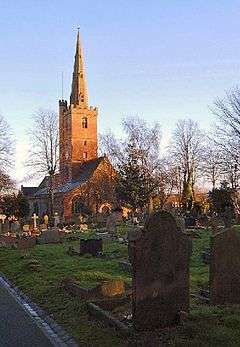
Worcestershire contained numerous exclaves, which were areas of land cut off from the main geographical area of Worcestershire and completely surrounded by the nearby counties of Warwickshire, Staffordshire, Gloucestershire, Herefordshire and Oxfordshire. The most notable islands were Dudley,[16] Evenlode,[17] Blockley[18] and the area around Shipston-on-Stour.[19] Herefordshire, Staffordshire, Warwickshire and Shropshire had their own exclaves within the main part of Worcestershire at Rochford,[20] Broome,[21] Clent,[22] Tardebigge (Tutnall and Cobley)[23] and Halesowen respectively. Tardebigge's history outside the county is even more colourful, changing hands from Worcestershire to Staffordshire and Warwickshire, before returning to Worcestershire at differing times over the centuries.[24] The southern boundary of the county was also complex, with parish boundaries penetrating deep into Gloucestershire and vice versa.
Worcestershire County Council came into existence following the Local Government Act 1888 and covered the historic traditional county,[25] except for two designated county boroughs at Dudley and Worcester.[26]
Birmingham's continuous expansion has been a major cause of Worcestershire's fluid boundary changes and associated housing issues.[27] The district of Balsall Heath, which had originally constituted the most northerly part of the parish of King's Norton, was the first area of the county to be added to the County Borough of Birmingham, on 1 October 1891. This was followed by Quinton Urban District, which was ceded to Birmingham in November 1909, and then by the Rural District of Yardley and the greater part of the Urban District of King's Norton and Northfield, which were absorbed into Birmingham under the Greater Birmingham Scheme on 9 November 1911.[28] Thus these areas were transferred from Worcestershire to Warwickshire. Dudley's historical status within the Diocese of Worcester and through its aristocratic links ensured that the exclave was governed on a largely autonomous basis.[29][30][8][31] Worcester was designated a county corporate, and thus became separate from the rest of Worcestershire.[32]
1926 boundary changes
In 1926, Dudley County Borough council purchased several square miles of land to the north of the town centre, mostly in Sedgley (Staffordshire), including Dudley Castle. This was to build the Priory Estate, a large new council estate on which construction began in 1929. The boundaries of Worcestershire were altered to include all of the proposed new housing estate in Dudley.[33]
1966–1974
During the Local Government reorganisation of April 1966, Dudley expanded beyond its historical boundaries and took in the bulk of Sedgley,[34] Brierley Hill and the south of Coseley as well as a small section of Amblecote.[35] The Local Government Act redefined its status and the County Borough of Dudley became part of Staffordshire, the county of which all of these areas had been part. At the same time, Worcestershire gained a new county borough named Warley, which was an amalgamation of Oldbury Urban District, Rowley Regis Urban District, the County Borough of Smethwick and parts of Dudley and Tipton.[36][37] During this reorganisation, the area of the administrative county grew only where Stourbridge took in the majority of Amblecote Urban District[38] from Staffordshire and the designation of Redditch in 1964 as a New Town. This in turn saw expansion into the area in and around the villages of Ipsley and Matchborough in Warwickshire. The Redditch New Town designation coincided with a considerable programme of social and private house building in Droitwich, Worcester, Bromsgrove, Kidderminster and along the Birmingham boundary at Frankley, Rubery and Rednal.[39] Frankley parish was later split into two: New Frankley and the area around Bartley Reservoir transferred from Bromsgrove District to Birmingham in April 1995; but the small village of Frankley remained in Worcestershire and became a new civil parish under the same name.
1974–1998
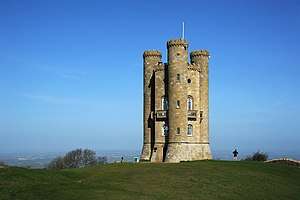
From 1974, the central and southern parts of the county were amalgamated with Herefordshire and with Worcester County Borough to form a single non-metropolitan county of Hereford and Worcester.[40] The County Boroughs of Dudley and Warley, along with Stourbridge and Halesowen, were incorporated into the new West Midlands Metropolitan county.[41][42] The West Midlands County Council existed for only a few years before abolition in April 1986, although the West Midlands still exists as a ceremonial county.[43]
1998–present
In the 1990s UK local government reform, the county of Hereford & Worcester was abolished, and the non-metropolitan county or shire county of Worcestershire regained its historic border with Herefordshire.[44] The recreated County of Worcestershire came into existence on 1 April 1998 as an administrative and ceremonial county, although this excluded the Black Country towns of Dudley, Halesowen, Oldbury and Stourbridge (which remained part of the West Midlands).[45] Worcestershire County Council was reformed, although some services are shared with the newly formed Herefordshire Council,[46] including waste management and the youth offending service.
The former Hereford and Worcester districts of Redditch, Worcester, Bromsgrove, Wychavon and Wyre Forest were retained with little or no change. However the Leominster and Malvern Hills districts straddled the historic border, so a new Malvern Hills district was constituted which straddled the pre-April 1974 county boundary to the west, south-west and north-west. The remaining parts of the former Hereford and Worcester district of Leominster, returned to Herefordshire.
Physical geography
The Malvern Hills, which run from the south of the county into Herefordshire, are made up mainly of volcanic igneous rocks and metamorphic rocks, some of which date from more than 1200 million years ago. They are designated as an Area of Outstanding Natural Beauty (AONB). The Worcestershire Beacon, which at 425m is the highest point in the county, lies in this range.[47]
The rest of the county consists of undulating hills and farmland stretching either side of the Severn valley. The Severn is the United Kingdom's longest river and flows through Bewdley, Stourport-on-Severn and Worcester.[48] The River Avon flows through the Worcestershire town on Evesham and joins the Severn at Tewkesbury, Gloucestershire.
Several coniferous and deciduous woodlands are located in the north of the county. The Vale of Evesham runs through the south of the county and to its south are the Cotswolds AONB.[49]
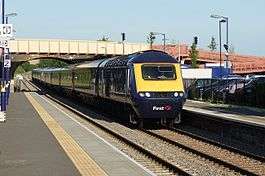
Green belt
Worcestershire contains a broad expanse of green belt area, widening to over 16 kilometres (9.9 mi) in places. It is part of the larger belt surrounding the West Midlands county, and first drawn up from the 1950s. All of the county's districts other than Malvern Hills contain some portion of the belt.
Sport
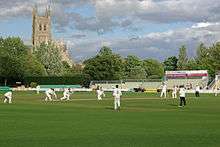
The largest and most successful football club in the county is Kidderminster Harriers. Founded in 1877 as a running club and doubling as a rugby club from 1880, the football club was founded in 1886. In 1987, the club won the FA Trophy for the first time, and seven years later reached the fifth round of the FA Cup, also winning the GM Vauxhall Conference title in 1994 but being denied Football League status as their Aggborough Stadium did not meet capacity requirements. However, when the club next won the Conference title six years later, their stadium had been upgraded and promotion was granted, giving the county its first (and thus far only) Football League members. However, the club's Football League membership was short-lived, as Harriers were relegated back to the Conference in 2005 after just five years in the Football League, and have yet to reclaim their status.[50]
The county is also represented by Alvechurch, Bromsgrove Sporting and Redditch United of the Southern Premier League, and Worcester City of the Midland Football League.
The county is home to Worcestershire County Cricket Club, traditionally first stop on for the touring national side's schedule in England.[51] Formed officially in 1865, the Club initially played in Boughton Park, before moving to its current New Road ground, which today can host 5,500 spectators, in 1895. The club has won five County Championships in its history, most recently in 1989.[52]
Worcester Rugby Football Club, the Worcester Warriors, are the county's largest and most successful Rugby Union team, having been promoted to the Premiership in 2004. The Warriors were relegated to the RFU Championship in 2010 but rebounded back to the Premiership in 2011. Worcester Warriors play at the Sixways Stadium on the outskirts of Worcester, holding over 12,000 spectators, thus making it the largest stadium in the county. Sixways has hosted the final of the LV Cup on three occasions.[53]
Culture
The village of Broadheath, about 10 kilometres (6.2 mi) northwest of the city of Worcester, is the birthplace of the composer Edward Elgar.
It is claimed that the county was the inspiration for the Shire, a region of J. R. R. Tolkien's fictional Middle-earth, described in The Hobbit and The Lord of the Rings. Tolkien was thought to have named Bilbo Baggins' house "Bag End" after his Aunt Jane's Worcestershire farm. Tolkien wrote of Worcestershire, "Any corner of that county (however fair or squalid) is in an indefinable way 'home' to me, as no other part of the world is."[54]
Worcestershire is one of the three counties associated with the Border Morris style of English folk dancing. Worcestershire Monkey is a popular Border Morris dance; although normally performed as a group of eight, it is sometimes danced en masse with multiple Border Morris sides performing the dance together.[55]
Media
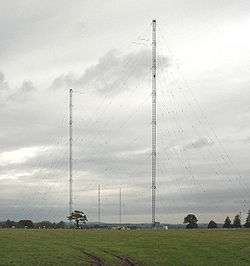
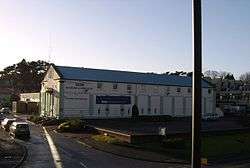
Worcestershire has a long history in radio broadcasting. The county is home to the Droitwich Transmitting Station near Wychbold, currently broadcasting BBC Radio 5 Live and commercial radio services - Absolute Radio and TalkSport on Medium Wave/AM and BBC Radio 4 on Long Wave. The site is the location of the British Broadcasting Corporation's most powerful long-wave transmitter, which during World War II, coded messages read during normal programme broadcasts, were received by the French Resistance.[56][57] Meanwhile, in 1939; the BBC bought the historic Wood Norton site near Evesham, and equipped the premises with a dozen temporary studios. These were to be used in the event of an evacuation of the BBC's operations in London and other urban areas. By 1940; Wood Norton was one of the largest broadcasting centres in Europe with an average output of 1,300 radio programmes a week.[58] The BBC monitoring service were also based at Wood Norton, where linguists, many of them foreign nationals, were hired to listen in to broadcasts from Europe until they were relocated to Caversham Park in early 1943. The move was made to release space at Wood Norton so that it could become the BBC's main broadcasting centre, should London have to be evacuated because of the threat from Nazi Germany's V-weapons. The site was also prepared for use during the Cold War, as an emergency broadcast centre.[59] The site is still in use for the BBC's engineering and technical training.
Local and regional radio
BBC Hereford & Worcester and Free Radio (formerly Wyvern FM) broadcast to both Herefordshire and Worcestershire on analogue and digital radio platforms,[60][61] whilst Signal 107 broadcasts to Kidderminster, Stourport-on-Severn, Bewdley and Droitwich.[62] A community radio station - Youthcomm Radio, is licensed to serve the Worcester area.[63] Meanwhile Capital Mid-Counties (formerly known as Touch FM), Sunshine Radio and Like Radio, broadcast to the county on VHF/FM and/or DAB Digital Radio.[64][65] Historically; West Midlands-based radio stations such as BBC Radio WM, BRMB and Beacon Radio have considered parts of Worcestershire as their broadcast areas.[66] However Wyvern FM, Beacon Radio, BRMB along with Mercia FM are now known collectively as 'Free Radio' and under the same Bauer Radio ownership.[67] Other regional stations, such as Heart, Greatest Hits Radio and Smooth Radio also cover the county.
In 2007 the Office of Communications (Ofcom) awarded a DAB Digital Radio multiplex licence for Herefordshire & Worcestershire to MuxCo Ltd.[68] MuxCo proposed new stations and a digital radio platform for Wyvern FM, Sunshine Radio and BBC Hereford & Worcester, who were initially licensed to broadcast on VHF/FM and/or AM. MuxCo eventually launched in December 2013 following changes in legislation through the Digital Economy Act 2010,[69] and utilises existing transmitter locations at Great Malvern, Ridge Hill and Bromsgrove.[70] The multiplex continues to uses the same transmission sites, albeit with an additional transmitter at Kidderminster[71] and broadcasts a combination of local and national services.[72] In 2008, MXR, who owned and operated the West Midlands regional DAB multiplex licence, improved coverage of DAB Digital Radio across other parts of the county to include Worcester and Malvern. This regional multiplex closed on 27 August 2013, partially replaced by CE Digital's Birmingham DAB Multiplex, who opened new transmitters at Lickey Hills and Headless Cross.[73] Ofcom has earmarked two potential 'Small Scale DAB' digital radio multiplexes within Worcestershire[74] - one at Worcester, and the other within Bromsgrove, Kidderminster and Redditch.[75] The legal framework for the potential new multiplexes come under 'The Small-Scale Radio Multiplex and Community Digital Radio Order 2019'.[76][77]
Economy
This is a chart of trend of regional gross value added of Worcestershire at current basic prices published (pp. 240–253) by Office for National Statistics with figures in millions of British Pounds Sterling.
| Year | Regional Gross Value Added[78] | Agriculture[79] | Industry[80] | Services[81] |
|---|---|---|---|---|
| 1995 | 5,047 | 225 | 1,623 | 3,200 |
| 2000 | 6,679 | 159 | 2,002 | 4,518 |
| 2003 | 7,514 | 182 | 1,952 | 5,380 |
Industry and agriculture

Fruit farming and the cultivation of hops were traditional agricultural activities in much of the county. During the latter half of the 20th century, this has largely declined with the exception southern area of the county around the Vale of Evesham, where orchards are still worked on a commercial scale. Worcester City's coat of arms includes three black pears, representing a now rare local pear variety, the Worcester Black Pear. The county's coat of arms follows this theme, having a pear tree with black pears. The apple variety known as Worcester Pearmain originates from Worcestershire, and the Pershore plum comes from the small Worcestershire town of that name, and is widely grown in that area.
Worcestershire is also famous for a number of its non-agricultural products. The original Worcestershire sauce, a savoury condiment made by Lea and Perrins, is made in Worcester, and the now-closed Royal Porcelain works was based in the city. The town of Malvern is the home of the Morgan traditional sports car.
Education
Worcestershire has a comprehensive school system with over thirty-five independent schools including the RGS Worcester, The King's School, Worcester, Malvern St James and Malvern College. State schools in Worcester, the Wyre Forest District, and the Malvern Hills District are two-tier primary schools and secondary schools whilst Redditch and Bromsgrove have a three-tier system of first, middle and high schools. Several schools in the county provide Sixth-form education including two in the city of Worcester. Several vocational colleges provide GCSE and A-level courses and adult education, such as South Worcestershire College, and an agricultural campus of Warwickshire College in Pershore. There is also the University of Worcester, which is located in the city itself and is home to the National Pollen and Aerobiology Research Unit and five other national research centres.
Towns and villages
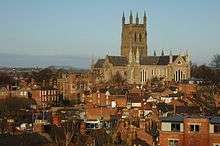
The county town and only city is Worcester. The other major settlements, Kidderminster, Bromsgrove and Redditch are satellite towns of Birmingham. There are also several market towns: Malvern, Bewdley, Evesham, Droitwich Spa, Pershore, Tenbury Wells, Stourport-on-Severn and Upton-upon-Severn. The village of Hartlebury housed the Bishop of Worcester from the 13th century until 2007.
Places of interest
| Key | |
| Abbey/Priory/Cathedral | |
| Accessible open space | |
| Amusement/Theme Park | |
| Castle | |
| Country Park | |
| English Heritage | |
| Forestry Commission | |
| Heritage railway | |
| Historic House | |
| Mosques | |
| Museum (free/not free) | |
| National Trust | |
| Theatre | |
| Zoo | |
- Avoncroft Museum of Historic Buildings
.svg.png)
- Bewdley – riverside historic Tudor town
- Broadway – a picturesque Cotswold village
- Croome Court


- Elgar Birthplace Museum
.svg.png)
- Forge Mill Needle Museum at Redditch, the only remaining working needle mill in the world.
.svg.png)
- Great Malvern Priory

- Greyfriars' House and Garden
.svg.png)

- Hanbury Hall


- Hartlebury Castle

- Harvington Hall

- Kemerton Court

- Malvern Hills – Area of Outstanding Natural Beauty

- Middle Littleton Tithe Barn – a restored 13th-century tithe barn
.svg.png)
- Morgan Cars – visitors centre and museum
.svg.png)
- Pershore Abbey

- River Severn at Worcester and Bewdley, River Avon at Pershore or Evesham
- River Teme and valley

- Severn Valley Railway at Kidderminster.

- Tenbury Wells with its unique Pump Rooms.
- The Commandery
.svg.png)
- The Fleece Inn – an ancient public house, now owned by the National Trust

- The Hive, Worcester – the new University and public library (opened in 2012)
- Wadborough
- Walton Hill and the Clent Hills

- West Midlands Safari Park near Bewdley.
- Witley Court at Great Witley – a burnt-out shell of a large English stately home, famous for its gigantic fountain, now restored to working order. Currently run by English Heritage.


- Worcester and Birmingham Canal

- Worcester Cathedral

- Worcestershire County Museum
.svg.png)
- Worcester City Art Gallery & Museum
- Worcester Porcelain Museum
.svg.png)
Local groups
- Worcestershire Wildlife Trust
- 29th Regiment of Foot
- West Midland Bird Club
See also
- Custos Rotulorum of Worcestershire - List of Keepers of the Rolls
- Healthcare in Worcestershire
- High Sheriff of Worcestershire
- Lord Lieutenant of Worcestershire
- Worcestershire (UK Parliament constituency) - Historical list of MPs for Worcestershire constituency
References
Notes
- In 2001 part of the White Other category. New category created for the 2011 census
- In 2001 part of the 'Other' category. New category created for the 2011 census
Citations
- "Privy Council Office-APPOINTMENT OF SHERIFFS". London Gazette. Retrieved 17 April 2019.
- "Census 2011:KS201EW Ethnic group, local authorities in England and Wales". ons.gov.uk. Office of National Statistics. Retrieved 9 December 2019.
- Worcestershire County Council. "Worcestershire County Council". Archived from the original on 21 November 2008.
- Brooks N, Cubitt C (1996). "St. Oswald of Worcester - Life and Influence". The administrative landscape of the Diocese of Worcester in the tenth century. p147
- Brooks, Alan; Pevsner, Nikolaus (2007). Worcestershire. New Haven and London: Yale University Press. p. 2. ISBN 9780300112986.
- James BSc(Hons) MSc PhD FIAP, K (11 April 2018). "Stourbridge's Western Boundary: A cornerstone of the historical landscape" (PDF). Stourbridge's Western Boundary. Retrieved 11 April 2018.
- Tinti F.(2010) Sustaining Belief: The Church of Worcester from c.870 to c.1100
- Carter, W.F. Additions to Grazebrook's 'The Barons of Dudley'. Chetwynd Papers.
- "The Domesday Book Online - Worcestershire E-L". www.domesdaybook.co.uk. Retrieved 11 April 2018.
- Mason 1979, p. 124.
- Laird, "A Topographical and Historical Description of the County of Worcester" c. 1814
- http://www.british-history.ac.uk/vch/worcs/vol3/pp1-4 British History Online: The hundred of Halfshire: Introduction and map, Pages 1-4. A History of the County of Worcester: Volume 3. Originally published by Victoria County History, London, 1913.
- Brooks "Introduction" St Wulfstan and His World p. 3
- Williams "Cunning of the Dove" St Wulfstan and His World pp. 33–35
- Bottled Waters of the World Archived 27 April 2009 at the Wayback Machine. Retrieved 9 August 2009
- Richardson, Eric (2000) The Black Country as Seen through Antique Maps, The Black Country Society ISBN 0-904015-60-2
- A Vision of Britain through Time Evenlode, Worcestershire – Retrieved 7 May 2020
- A Vision of Britain through Time Blockley, Worcestershire – Retrieved 7 August 2014
- Worcester Branch of the Birmingham & Midland Society for Genealogy and Heraldry Shipston-upon-Stour Archived 10 August 2011 at the Wayback Machine – Retrieved 7 May 2020
- Worcester Branch of the Birmingham & Midland Society for Genealogy and Heraldry Rochford, Herefordshire Archived 10 August 2011 at the Wayback Machine – Retrieved 7 May 2020
- Worcester Branch of the Birmingham & Midland Society for Genealogy and Heraldry Broome, Staffordshire Archived 10 August 2011 at the Wayback Machine – Retrieved 7 May 2020
- Harbach M, Genealogy UK & Ireland – Retrieved 29 July 2011
- A Vision of Britain through Time Tardebigge, Warwickshire – Retrieved 27 May 2020
- Worcester Branch of the Birmingham & Midland Society for Genealogy and Heraldry Tardebigge Archived 6 September 2011 at the Wayback Machine – Retrieved 7 May 2020
- Webb, Sidney; Webb, Beatrice (1906). English Local Government from the Revolution to the Municipal Corporations Act. 1: The Parish and the County. London: Longman's Green and Co. pp. 283–287.
- HM Government Legislation Local Government Act 1888 – Retrieved 7 May 2020
- A Vision of Britain through Time Birmingham Municipal Borough/County Borough, Warwickshire Archived 30 September 2007 at the Wayback Machine – Retrieved 7 May 2020
- British History Online A History of the County of Warwick: Volume 7: The City of Birmingham – Retrieved 27 May 2020
- British History Online The hundred of Halfshire: Introduction and map - Retrieved 07 May 2020
- Chan. Inq. p.m. (Ser. 2), clxv, 192.
- "celtic-casimir.com". www.celtic-casimir.com. Retrieved 11 April 2018.
- Chisholm, Hugh, ed. (1911). . Encyclopædia Britannica. 28 (11th ed.). Cambridge University Press. pp. 821–822.
- "A History of Dudley". Localhistories.org. Archived from the original on 10 December 2012. Retrieved 7 November 2012.
- Staffordshire County Council Staffordshire Place Guide – Sedgley – Retrieved 7 May 2020
- Staffordshire County Council Staffordshire Place Guide – Amblecote – Retrieved 7 May 2020
- "Warley County Borough". Vision of Britain. Retrieved 29 July 2014.
- West Midlands Order 1965, S.I. 1965, no. 2139, pp. 5-7, 85-6, 120, 122-3.
- HM Government Legislation – The West Midland Counties Order 1965
- HM Government Legislation Town Development Act 1952 – Retrieved 15 August 2014
- Local Government in England: Government Proposals for Reorganisation (Cmnd. 4584) Circular 8/71 map
- H.M. Government Local Government Act 1972 – Retrieved 07 May 2020
- Hansard 1803–2005 Local Government (West Midlands Order) Debate – Retrieved 07 May 2020
- HM Government Legislation Local Government Act 1985 – Retrieved 07 May 2020
- HM Government Legislation The Hereford and Worcester (Structural, Boundary and Electoral Changes) Order 1996 – Retrieved 7 May 2020
- House of Commons Debates – Parliamentary Business – Retrieved 7 May 2020
- Final Recommendations for the Future Local Government of Hereford and Worcester. December 1994 – Retrieved 16 May 2013
- "County Tops". Hill-bagging.co.uk. Archived from the original on 27 September 2007. Retrieved 15 June 2013.
- "Learning Zone Class Clips - The course of the River Severn - from source to sea - Geography Video". BBC. 1 January 1970. Archived from the original on 5 May 2013. Retrieved 15 June 2013.
- "NAAONB Website". Aonb.org.uk. Archived from the original on 24 June 2013. Retrieved 15 June 2013.
- "Archived copy". Archived from the original on 10 August 2012. Retrieved 30 October 2016.CS1 maint: archived copy as title (link)
- "Archived copy" (PDF). Archived from the original (PDF) on 24 May 2010. Retrieved 26 February 2014.CS1 maint: archived copy as title (link)
- "Archived copy" (PDF). Archived from the original (PDF) on 2 March 2014. Retrieved 26 February 2014.CS1 maint: archived copy as title (link)
- "Worcester Warriors - Official website of Worcester Warriors Rugby Club". www.warriors.co.uk. Archived from the original on 27 February 2014. Retrieved 2 May 2018.
- Humphrey, C. 1977 Tolkien: A Biography New York: Ballantine Books. ISBN 0-04-928037-6
- "Archived copy". Archived from the original on 6 January 2014. Retrieved 5 January 2014.CS1 maint: archived copy as title (link) Worcestershire Monkey , Wicket Brood website
- BBC Feature Retrieved 07 May 2020
- BBC Engineering Droitwich Calling (Archive) - Retrieved 7 May 2020
- Pawley, E. (1972), Cutmore, N. (Ed.), Laven, P (Ed.) History of the BBC - Wood Norton
- Subterranea Britannica Wood Norton - Retrieved 7 May 2020
- Ofcom BBC Hereford & Worcester licence - Retrieved 7 May 2020
- Ofcom Free Radio (Hereford/Worcester) - Retrieved 7 May 2020
- Ofcom Signal 107 - Retrieved 7 May 2020
- Ofcom Youthcomm Radio - Retrieved 7 May 2020
- Ofcom Sunshine Radio (Herefordshire and Monmouthshire)
- Radio Today Global confirms Capital FM to replace Quidem stations - Retrieved 7 May 2020
- Allen, D.P. (2011) Independent Local Radio (ILR) in the West Midlands, 1972-1984: a comparative study of BRMB Radio and Beacon Radio.- Retrieved 7 May 2020
- Bauer Media Free Radio Brand Retrieved 7 May 2020
- Ofcom Ofcom awards new local digital radio multiplex licence for Herefordshire and Worcestershire - Retrieved 7 May 2020
- HM Government Digital Econmy Act - Section 35 - Retrieved 7 May 2020
- Ofcom Herefordshire and Worcestershire DAB Multiplex Ownership - Retrieved 7 May 2020
- Ofcom Herefordshire and Worcestershire - Retrieved 7 May 2020
- MuxCo Digital Broadcast Radio Predicted On-Air Coverage Herefordshire & Worcestershire Block 12A Local DAB Multiplex - Retrieved 7 May 2020
- Ofcom Digital Broadcast Radio Predicted On-Air Coverage Birmingham Block 11C Local DAB Multiplex - retrieved 7 May 2020
- Ofcom under new licensing guidelines Licensing small-scale DAB New powers and duties proposed by government under new licensing guidelines - Retrieved 8 May 2020
- Ofcom Statement licensing Small-Scale DAB - Retrieved 6 May 2020
- HM Government The Small-scale Radio Multiplex and Community Digital Radio Order 2019 - Contents - Retrieved 8 May 2020
- HM Government The Small-scale Radio Multiplex and Community Digital Radio Order 2019 - Explanation Guide - Retrieved 8 May 2020
- Components may not sum to totals due to rounding
- includes hunting and forestry
- includes energy and construction
- includes financial intermediation services indirectly measured
Sources
- "Spa Towns: Malvern" 27 October, retrieved 24 June 2006
External links
| Wikisource has the text of an Encyclopaedia Britannica (9th ed.) article about Worcestershire. |

- Worcestershire County Council main site

